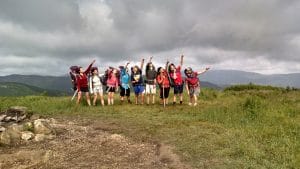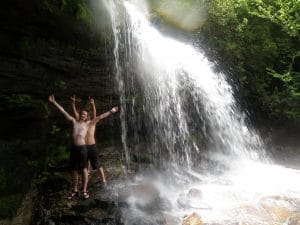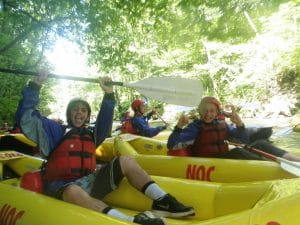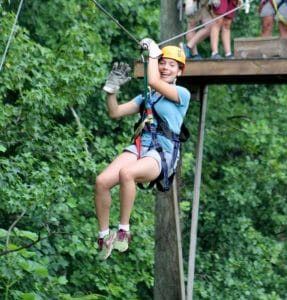By Amanda Fox, marketing director
Unless you’ve spent any length of time in western North Carolina, it can be hard to imagine why so many folks—from north and south AND west—flock to this region in warmer months. Outside magazine gets it: In their recent annual Best of Travel’s “30 Best Trips of 2015,” they named North Carolina as the “Best Domestic Adventure Hub.”
Though this snippet touches on the state as a whole, they give a particular shout-out to the region in which the Adventure Treks office is located: “In the west, there’s world-class singletrack and road riding in the Blue Ridge mountains… 96 miles of Appalachian Trail, and some of the country’s best whitewater at the Nantahala Outdoor Center.”
While the Appalachians may not sound as exciting or exotic as California or Alaska, here are 5 reasons Adventure Treks loves the southern tail of the Blue Ridge mountains, why our leadership team lives here, and why the Blue Ridge Explorer trip is one of our favorites.
 Though the highest summit in the Appalachians, Mt. Mitchell, tops out at just under 6,700 feet, during their formation more than 300 million years ago, the Blue Ridge Mountains were among the highest peaks in the world. On the Blue Ridge Explorer trip, students will get to hike in the Shining Rock Wilderness, the largest protected wilderness area in the state. They’ll traverse several peaks over 6,000 feet, including Black Balsam Knob (6,214 feet, pictured), from which they’ll be able to view several other impressive summits like Mt. Mitchell, 45 miles to the northeast, on clear days. What’s most awe-inspiring, however, is the panoramic view of the lush, vividly green rolling hills of the Black Balsam range.
Though the highest summit in the Appalachians, Mt. Mitchell, tops out at just under 6,700 feet, during their formation more than 300 million years ago, the Blue Ridge Mountains were among the highest peaks in the world. On the Blue Ridge Explorer trip, students will get to hike in the Shining Rock Wilderness, the largest protected wilderness area in the state. They’ll traverse several peaks over 6,000 feet, including Black Balsam Knob (6,214 feet, pictured), from which they’ll be able to view several other impressive summits like Mt. Mitchell, 45 miles to the northeast, on clear days. What’s most awe-inspiring, however, is the panoramic view of the lush, vividly green rolling hills of the Black Balsam range.
 Waterfalls, waterfalls, waterfalls! There are as many as 1,500 waterfalls in North Carolina, and the other area in which we backpack, Panthertown Valley, houses at least eight of the prettiest ones. Students will have the chance to stop and swim around beneath the larger falls, including Schoolhouse Falls (pictured). There’s no better way to cool off on a hot day than having “splash wars” in crystal-clear swimming holes next to sandy beaches! Panthertown, a 6,700-acre tract of gorgeous wilderness, also contains huge granite domes, validating its nickname “Yosemite of the East.”
Waterfalls, waterfalls, waterfalls! There are as many as 1,500 waterfalls in North Carolina, and the other area in which we backpack, Panthertown Valley, houses at least eight of the prettiest ones. Students will have the chance to stop and swim around beneath the larger falls, including Schoolhouse Falls (pictured). There’s no better way to cool off on a hot day than having “splash wars” in crystal-clear swimming holes next to sandy beaches! Panthertown, a 6,700-acre tract of gorgeous wilderness, also contains huge granite domes, validating its nickname “Yosemite of the East.”
 More water! Just as impressive as our host of waterfalls is the sheer volume of rivers running through western North Carolina. Known as a hotbed for boating enthusiasts, our students spend five to six days inflatable kayaking, canoeing, and whitewater rafting the great waterways of the region. The Chattooga River, the first river east of the Mississippi to be designated a Wild and Scenic River, has some of the most exciting rapids we paddle. They’ll also hop into inflatable kayaks, aka “duckies,” down the Nantahala River, culminating with the optional drop down the dramatic, class 3 Nantahala Falls. Finally, Blue Ridge students will learn and hone canoeing skills on either the serene Lake Santeetlah (pictured) or the French Broad River, which is the third-oldest river in the world!
More water! Just as impressive as our host of waterfalls is the sheer volume of rivers running through western North Carolina. Known as a hotbed for boating enthusiasts, our students spend five to six days inflatable kayaking, canoeing, and whitewater rafting the great waterways of the region. The Chattooga River, the first river east of the Mississippi to be designated a Wild and Scenic River, has some of the most exciting rapids we paddle. They’ll also hop into inflatable kayaks, aka “duckies,” down the Nantahala River, culminating with the optional drop down the dramatic, class 3 Nantahala Falls. Finally, Blue Ridge students will learn and hone canoeing skills on either the serene Lake Santeetlah (pictured) or the French Broad River, which is the third-oldest river in the world!
 Chances are your teenager has seen the movie The Hunger Games, and it’s also likely that your teenagers knows that filming took place all over western North Carolina. On the Blue Ridge Explorer, our students mountain bike through DuPont State Forest, where some of the more memorable movie scenes take place at Triple Falls (pictured) and Bridal Veil Falls. DuPont’s single-track trails attract mountain bikers of all skill levels, and many of its trails offer something that most Appalachian forests don’t: slickrock, i.e. smooth, wind-polish rock trails, that wind through beautiful waterfalls and rare habitats like high-elevation bogs.
Chances are your teenager has seen the movie The Hunger Games, and it’s also likely that your teenagers knows that filming took place all over western North Carolina. On the Blue Ridge Explorer, our students mountain bike through DuPont State Forest, where some of the more memorable movie scenes take place at Triple Falls (pictured) and Bridal Veil Falls. DuPont’s single-track trails attract mountain bikers of all skill levels, and many of its trails offer something that most Appalachian forests don’t: slickrock, i.e. smooth, wind-polish rock trails, that wind through beautiful waterfalls and rare habitats like high-elevation bogs.
 Last but not least, the wildly diverse ecological systems of North Carolina help make the Blue Ridge Explorer trip so memorable. Students will have a birds-eye view as they zipline through the Green River Gorge, whizzing through deciduous forests down 1,100 vertical feet. This gorge has some of the most dramatic landscapes of any area we visit in North Carolina, and is bursting with plant and animal life as one of the most bio-diverse regions in the eastern United States. This zipline is one of the fastest in the United States—the perfect end to a wonderfully fun trip.
Last but not least, the wildly diverse ecological systems of North Carolina help make the Blue Ridge Explorer trip so memorable. Students will have a birds-eye view as they zipline through the Green River Gorge, whizzing through deciduous forests down 1,100 vertical feet. This gorge has some of the most dramatic landscapes of any area we visit in North Carolina, and is bursting with plant and animal life as one of the most bio-diverse regions in the eastern United States. This zipline is one of the fastest in the United States—the perfect end to a wonderfully fun trip.